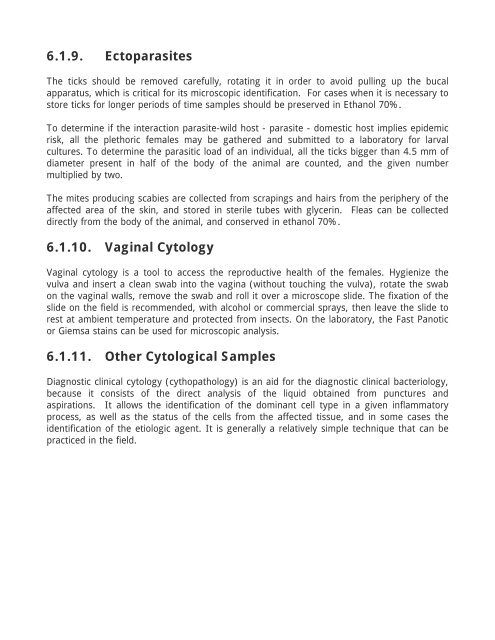TAPIR FIELD VETERINARY MANUAL - Tapir Specialist Group
TAPIR FIELD VETERINARY MANUAL - Tapir Specialist Group
TAPIR FIELD VETERINARY MANUAL - Tapir Specialist Group
Create successful ePaper yourself
Turn your PDF publications into a flip-book with our unique Google optimized e-Paper software.
6.1.9. Ectoparasites<br />
The ticks should be removed carefully, rotating it in order to avoid pulling up the bucal<br />
apparatus, which is critical for its microscopic identification. For cases when it is necessary to<br />
store ticks for longer periods of time samples should be preserved in Ethanol 70%.<br />
To determine if the interaction parasite-wild host - parasite - domestic host implies epidemic<br />
risk, all the plethoric females may be gathered and submitted to a laboratory for larval<br />
cultures. To determine the parasitic load of an individual, all the ticks bigger than 4.5 mm of<br />
diameter present in half of the body of the animal are counted, and the given number<br />
multiplied by two.<br />
The mites producing scabies are collected from scrapings and hairs from the periphery of the<br />
affected area of the skin, and stored in sterile tubes with glycerin. Fleas can be collected<br />
directly from the body of the animal, and conserved in ethanol 70%.<br />
6.1.10. Vaginal Cytology<br />
Vaginal cytology is a tool to access the reproductive health of the females. Hygienize the<br />
vulva and insert a clean swab into the vagina (without touching the vulva), rotate the swab<br />
on the vaginal walls, remove the swab and roll it over a microscope slide. The fixation of the<br />
slide on the field is recommended, with alcohol or commercial sprays, then leave the slide to<br />
rest at ambient temperature and protected from insects. On the laboratory, the Fast Panotic<br />
or Giemsa stains can be used for microscopic analysis.<br />
6.1.11. Other Cytological Samples<br />
Diagnostic clinical cytology (cythopathology) is an aid for the diagnostic clinical bacteriology,<br />
because it consists of the direct analysis of the liquid obtained from punctures and<br />
aspirations. It allows the identification of the dominant cell type in a given inflammatory<br />
process, as well as the status of the cells from the affected tissue, and in some cases the<br />
identification of the etiologic agent. It is generally a relatively simple technique that can be<br />
practiced in the field.










